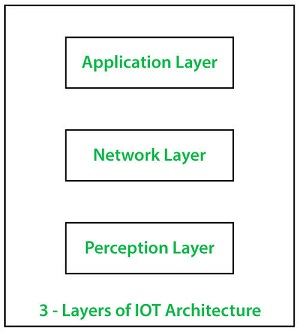
 Data Structure
Data Structure Networking
Networking RDBMS
RDBMS Operating System
Operating System Java
Java MS Excel
MS Excel iOS
iOS HTML
HTML CSS
CSS Android
Android Python
Python C Programming
C Programming C++
C++ C#
C# MongoDB
MongoDB MySQL
MySQL Javascript
Javascript PHP
PHP
- Selected Reading
- UPSC IAS Exams Notes
- Developer's Best Practices
- Questions and Answers
- Effective Resume Writing
- HR Interview Questions
- Computer Glossary
- Who is Who
3-Layer of IOT architecture?
IOT represents the Internet of Things. It is a network of physical objects or people known as "things" that are installed with applications, electronics, networks, and sensors that enable these objects to collect and exchange information. The objective of IOT is to extend to web connectivity from standard devices such as computers, mobile, tablets to associatively dumb devices like a toaster.
Components of IOT
There are various components of IOT which are as follows ?
Sensors/Devices
Sensors or devices are a component that supports us to collect live information from the surrounding environment. All this information can have several levels of complexities. It can be a simple temperature monitoring sensor, or it can be in the design of the video feed.
Data Processing
The data is collected, and received from the cloud. The software implements processing of the gathered information after the data is received. This process can be only checking the temperature, reading on devices such as AC or heaters. It can constantly also be very difficult like recognizing objects, using computer vision on video.
User Interface
The data required to be available to the end-user in some methods which can be managed by triggering alarms on their phones or transmitting those notifications through email or text message. The user can need an interface that actively tests their IOT system.
Connectivity
All the collected information is transmitted to a cloud infrastructure. The sensors must be connected to the cloud using several channels of communication. These communication mediums are cellular or satellite networks, Bluetooth, WI-FI, WAN, etc.
3 - Layers of IOT Architecture
There are three layers of IOT architecture which are as follows ?

Perception Layer
These layer supports sensors and installed systems are used. These sensors collect huge amount of information depending on the requirements.
This also contains edge devices, sensors, and actuators that connect with the surroundings. It can find specific spatial parameters or find other intelligent things /objects in the surroundings.
Network Layer
The network layer generates a logical association between the sender and the user by providing a logical method. This layer switches and routes message packets as important to receive them to their destination.
It is important for sending and delivering message packets. The network layer makes routing decisions and promotes the packets for devices that are farther away than a single connection.
The network layer can also break huge packets into small blocks if the packet is larger than the most considerable data link layer. The network reassembles the fragments into packets at the receiving end.
Application Layer
This layer supports services for client and software functions. It decides how the user will use the data network. It allows the client to use the structure.
For instance, it supports network-based services to the end-user. There are famous application layer protocols are X.400 (Electronic Mail Protocol), X.500 (Directory Server Protocol), FTP (File Transfer Protocol), and rlogin (Remote Login Protocol).

